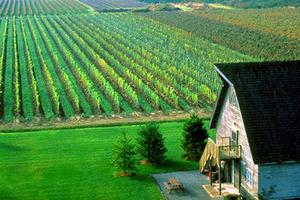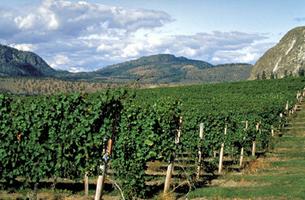According to Norwegian sagas, Viking explorer Leif Ericsson discovered grapes when he landed on the American continent around 1001. He named the place Vinland. Although speculation continues as to whether Ericsson found blueberries or grapes at his landfall, L’Anse Aux Meadows, Newfoundland, it is certain that wild grapes grew along the eastern seaboard of North America. Johann Schiller made good use of these grapes in the early 19th century — though his claim to be "the Father of the Canadian wine industry" is perhaps overstated.
Schiller, a retired German corporal, was given a land grant just west of Toronto. In 1811, he planted a small vineyard from cuttings of wild vines he found growing along the banks of the Credit River. Schiller made wine from these domesticated grapes and sold it to his neighbours. Thirty-five years later, the estate was bought by an aristocratic Frenchman, Justin de Courtenay, who had unsuccessfully tried to replicate the taste of red Burgundy in Québec. He had better luck in Ontario and his Gamay won a prize at the 1867 Paris Exposition.
The first true commercial Canadian winemaking operation began in 1866 when three gentlemen farmers from Kentucky acquired land on Pelee Island — Canada's most southerly and warmest point. Here they planted 30 acres of North American Catawba grapes. A few months later, they were joined on the island by two English brothers, Edward and John Wardoper, who planted their own vineyard, half the size of the first. Gradually, vineyards were planted on the mainland, moving east along the shores of Lake Erie to the Niagara Peninsula, where Canada's major concentration of vineyards is situated today.
The first vineyards in British Columbia were planted in the 1860s at the Oblate Mission of Father Charles Pandosy near Kelowna in the Okanagan Valley. It wasn't until the 1930s that the first winery was established in the valley.
By 1890 there were 41 commercial wineries in Canada, 35 of them in Ontario. In the Okanagan Valley of British Columbia and along Québec's St. Lawrence shoreline it was the Church rather than the regions' farmers that encouraged the planting of vineyards and fostered the art of winemaking.
During Canada's 11 years of Prohibition (1916–27), the making and selling of wine was not illegal (thanks to an aggressive grape-growers' lobby that managed to have wine exempted from Prohibition laws); and Canadians could buy sweet wines labelled as "ports" and "sherries" with an alcoholic strength of 20 per cent by volume. Following Prohibition, the provincial liquor board system was put in place across the country to control and regulate the production, distribution and sale of beverage alcohol.
It was not until the mid-1970s in Ontario and British Columbia that the supremacy of the large wineries was challenged by the appearance of small family wineries described as boutique or "farm gate" ventures. In 1997, Canada had over 110 licensed wineries classified according to the scale of their production: large commercial enterprises, estate wineries and small-scale farm operations.
Wine from locally grown grapes is currently made in four provinces — Ontario, British Columbia, Québec and Nova Scotia — with small fruit wine operations in New Brunswick, Newfoundland and Prince Edward Island.
Climate
Canada is a cool-climate wine growing country, like New Zealand, northern France, Italy, and Germany. Quality can vary significantly from vintage to vintage, as it does in Bordeaux or Burgundy.
For many years it was believed that Vitis vinifera (the noble European grape varieties such as Chardonnay, Riesling, Cabernet Sauvignon, Merlot, and Pinot Noir) could not survive the rigours of Canadian winters and the freeze-thaw-freeze cycle of early spring. Two-thirds of Ontario’s 15,000 acres are planted with the noble European varieties; the rest are winter-hardy hybrids, Vidal, Seyval Blanc, Baco Noir and Maréchal Foch, and North American labrusca varieties such as Concord and Niagara (for food processing and table grapes).
Nonetheless, the awards and medals won by Canadian wineries in competitions at home and abroad for Chardonnays, Rieslings and the noble red varieties are testimony to the quality of the raw material grown in the vineyard and the techniques employed to turn them into fine wine.
Virtually unique to Canada’s vineyards is the ability to produce icewine consistently from year to year. This expensive honeyed nectar, made from grapes left to freeze on the vine and then pressed in their frozen state, has attracted a worldwide market, winning competition medals wherever it is entered.
Wine Laws
The production and sale of alcoholic beverages is a provincial jurisdiction, which means that wine regulations vary from province to province. But a national appellation of origin has been established, called the Vintners Quality Alliance (VQA), similar to wine regulations in European wine-growing countries. The national VQA regulations set minimum standards of production and delimit grape-growing areas.
The provincial VQA regulations governing the production of wine in Ontario and British Columbia are slightly more stringent. The most significant regulations state that wines must be 100 per cent grown in their designated viticultural area and have minimum sugar values set for specified grape varieties. To receive the VQA seal (VQA will appear on the bottle), the wines must be tested by both a lab and an independent panel to ensure their general quality and varietal integrity.
British Columbia
There are five designated wine-growing areas in British Columbia — Okanagan Valley, Similkameen Valley, Fraser Valley, Vancouver Island and the Gulf Islands. There are also four emerging regions: Shuswap, North Okanagan, Thompson Nicola and the West Kootenays. Taken together, winegrowers farm a vineyard surface of some 9,800 acres (2014 figures). The most significant region, Okanagan Valley, where most of British Columbia's wineries and vineyards are located, is technically a desert at its southern end that borders on Washington State. Daytime temperatures here can reach 40°C, but the nights are very cool allowing the grapes to maintain their acidity. This part of the valley, warmer and more arid than California’s Napa Valley, is basically on the same latitude as Champagne and the Rheingau but, unlike these northerly European regions, the intense heat of summer, the lack of rainfall and the cool evenings require that the vines be irrigated.
The growth in the number of BC wineries has been exponential. In 1990 there were 17 wineries; the current number is 273 (as of July 2014).The industry here at the end of the 20th century relied on many lesser-known German varieties such as Optima, Ehrenfelser, Kerner, Seigfried Rebe. But these varieties have fallen out of favour, replaced by the noble European varieties, Pinot Gris, Chardonnay, Gewurztraminer, Riesling, Sauvignon Blanc, Pinot Blanc and Viognier. The warmer southern end of the Okanagan is renowned for its flavourful reds produced from Merlot, Syrah/Shiraz, Pinot Noir, Cabernet Sauvignon, Cabernet Franc and Gamay Noir. Collectively, the industry crushes about 32,000 tonnes of grapes each year.
In 2014, the British Columbia Wine Authority approved the first sub-Designated Viticultural Area in the province the Golden Mile Bench, which is located on the western slope of the Okanagan Valley, south of Oliver
Ontario
Unlike British Columbia, which is a vertical north–south wine region, Ontario’s vineyards stretch horizontally east–west from Prince Edward County through the Niagara Peninsula to Lake Erie North Shore (a designated viticultural area that includes Pelee Island, Canada’s most southerly point and the location of the first commercial winery). Currently there are 235 wineries in Ontario (150 in the VQA program) supplied by 17,000 vineyard acres (14,600 in Niagara Peninsula; 1,000 in Lake Erie North Shore and 800 in Prince Edward County). New wine growing areas are being developed in Northumberland County and as far north as Collingwood. The average tonnage crushed per year in Ontario is 64,000 tonnes.
The vineyard areas of Ontario, where over 70 per cent of Canada’s wines are grown and produced, are on roughly the same latitudes as southern Oregon and the Chianti region. Winters are decidedly cold but in terms of heat units and rainfall, Ontario is similar to other cool-climate wine regions such as Burgundy. The moderating waters of Great Lakes Erie and Ontario together with the frost-dispelling wind effect produced by the Niagara Escarpment allow many of the preferred vinifera varieties to flourish. In most vintages claret-style red wines made from Cabernet Sauvignon or Cabernet/Merlot blends can be achieved, as well as flavourful Pinot Noir, Syrah and Gamay. Chardonnay and Riesling provide world class white wines, both still and sparkling. Ontario is the world’s largest producer of icewine.
Québec
Québec is the least likely of all Canadian wine regions. Wines are grown south of Montréal, along the St. Lawrence shore and as far north as Québec City. The centre of the province's small but enthusiastic winegrowing zone is the old town of Dunham. The wineries, for the most part strung out along the American border, battle the elements to produce wine for the tourist trade. During the winter months the vines have to be covered with earth by the method of back-ploughing to protect them from the fierce cold; they are uncovered by machine in the spring. Vines overlooked by the machines are uncovered by hand.
The average sunshine hours during the growing season in Dunham are 1,150 (in Burgundy they average 1,300 to 1,500 hours) but topographical features create highly localized warm spots that allow the hardiest vines to survive, if not flourish.
The growth in the number of Québec wineries in percentage terms is the most significant in Canada. In 2006 there were 42 producers of wines made from locally-grown grapes on less than 1,600 acres. By 2014 there were 125 with more than double the acreage.
Québec's cottage wineries produce mainly white wines (80 per cent white, 20 per cent red), mostly very fresh Seyval Blanc. Vidal, Chardonnay, Riesling, Aurore, Cayuga, Ortega, Bacchus and the hybrid Geisenheim clone are also grown. In reds, de Chaunac, Maréchal Foch, Gamay, Cabernet Franc, Chancellor, Vidal Noir and Dornfelder are grown.
Nova Scotia
Midway between the equator and the North Pole, Nova Scotia boasts 14 wineries and a total of 720 acres of vineyards, which concentrate on both vinifera and hybrid grape varieties. Nova Scotia has six main wine growing regions: the Annapolis Valley, Avon River Valley, Bear River Valley, Gaspereau Valley, LeHave River Valley and the Northumberland Coast.
Major plantings are L’Acadie, Muscat and Seyval in whites; Lucy Kuhlman, Léon Millot and Maréchal Foch in reds. However, the list of grape varietals grown and used in winemaking is well over 30. The fresh acidity in the wines makes them an ideal accompaniment to the province’s abundant seafood. Of special note are the sparkling wines produced in the Annapolis and Gaspereau Valleys. Annual production in Nova Scotia has reached 2.8 million bottles.

 Share on Facebook
Share on Facebook Share on X
Share on X Share by Email
Share by Email Share on Google Classroom
Share on Google Classroom





